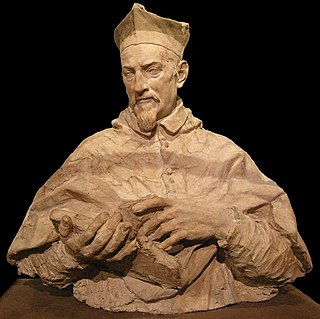
Alessandro Algardi was an Italian high-Baroque sculptor active almost exclusively in Rome, where for the latter decades of his life, he was, along with Francesco Borromini and Pietro da Cortona, one of the major rivals of Gian Lorenzo Bernini. He is now most admired for his portrait busts that have great vivacity and dignity.

Gian LorenzoBernini was an Italian sculptor and architect. While a major figure in the world of architecture, he was more prominently the leading sculptor of his age, credited with creating the Baroque style of sculpture. As one scholar has commented, "What Shakespeare is to drama, Bernini may be to sculpture: the first pan-European sculptor whose name is instantaneously identifiable with a particular manner and vision, and whose influence was inordinately powerful ..." In addition, he was a painter and a man of the theater: he wrote, directed and acted in plays, for which he designed stage sets and theatrical machinery. He produced designs as well for a wide variety of decorative art objects including lamps, tables, mirrors, and even coaches.
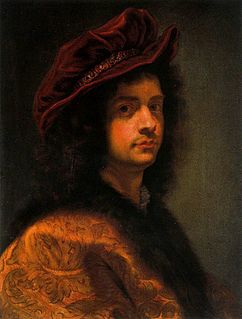
Giovanni Battista Gaulli, also known as Baciccio or Baciccia, was an Italian artist working in the High Baroque and early Rococo periods. He is best known for his grand illusionistic vault frescos in the Church of the Gesù in Rome, Italy. His work was influenced by Gian Lorenzo Bernini.
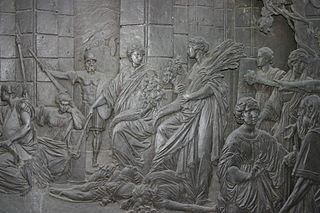
Francesco Mochi was an Italian early-Baroque sculptor active mostly in Rome and Orvieto.

The Minor Basilica of St. Lawrence in Damaso or simply San Lorenzo in Damaso is a parish and titular church in central Rome, Italy that is dedicated to St. Lawrence, deacon and martyr. It is incorporated into the Palazzo della Cancelleria, which enjoys the extraterritoriality of the Holy See.

Blessed Ludovica Albertoni is a funerary monument by the Italian Baroque artist Gian Lorenzo Bernini. The Trastevere sculpture is located in the specially designed Altieri Chapel in the Church of San Francesco a Ripa in Rome, Italy. Bernini started the project in 1671, but his work on two other major works—The Tomb of Pope Alexander VII and the Altar of the Blessed Sacrament in St. Peter's Basilica—delayed his work on the funerary monument. Bernini completed the sculpture in 1674; it was installed by 31 August 1674.

The Rape of Proserpina, more accurately translated as the Abduction of Proserpina, is a large Baroque marble group sculpture by Italian artist Gian Lorenzo Bernini, executed between 1621 and 1622, when Bernini's career was in its early stage. The group, finished when Bernini was just 23 years old, depicts the abduction of Proserpina, who is seized and taken to the underworld by the god Pluto. It features a Pluto holding a Proserpina aloft, and a Cerberus to symbolize the border into the underworld that Pluto carries Proserpina into.

Antonio Giorgetti was an Italian sculptor. He was born and died in Rome, where he spent his entire career, a disciple of Gian Lorenzo Bernini. His most prominent sculpture is the Angel with the Sponge on the Ponte Sant'Angelo, where he was working under the direction of Bernini, who provided sketches and in some instances bozzetti for the angels. For Borromini's Capella Spada in the church of San Girolamo della Carità (1660), Giorgetti provided the two kneeling angels that hold up the jasper draperies that serve as a balustrade to the altar.

Memorial to Maria Raggi is a sculptural monument designed and executed by the Italian artist Gian Lorenzo Bernini, started in 1647 and finished in 1653. The monument is attached to a pillar in a nave of the church of Santa Maria sopra Minerva in Rome.

The Bust of Giovanni Battisti Santoni is a sculptural portrait by the Italian artist Gian Lorenzo Bernini. Believed to be one of the artist's earliest works, the bust forms part of a tomb for Santoni, who was majordomo to Pope Sixtus V from 1590 to 1592. The work was executed sometime between 1613 and 1616, although some have dated the work as early as 1609, including Filippo Baldinucci. The work remains in its original setting in the church of Santa Prassede in Rome.

The Bust of Francesco Barberini is a marble sculpture by the Italian artist Gian Lorenzo Bernini, now in the National Gallery of Art in Washington, D.C. It was executed in 1623. It was commissioned by Pope Urban VIII, who was nephew of Francesco Barberini, an apostolic protonotary. Francesco had actually died in 1600 so Bernini created the bust from an existing painted portrait. The painted portrait is in Corsini Collection in Florence; Bernini made close use of the design, although the painting was a three quarter portrait as opposed to a bust of head, shoulders and upper body.

The Bust of Alessandro Peretti di Montalto is a portrait sculpture by the Italian artist Gian Lorenzo Bernini. Executed in 1622 and 1623, the sculpture is now in the Kunsthalle Hamburg, in Germany. Although possibly mentioned by one of Bernini's early biographers, the bust had been considered lost and therefore makes no appearance in Rudolf Wittkower's catalogue of Bernini’s sculptures of 1955. However, the bust was identified in the 1980s and is now considered an authentic work by Bernini.
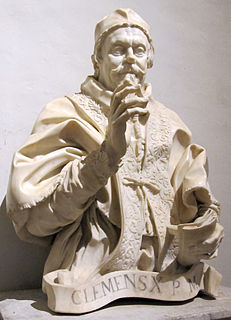
The Statue of Pope Clement X is one of the final sculptural works executed by the Italian artist Gian Lorenzo Bernini. It depicts Pope Clement X in the act of benediction, and is housed in the Galleria Nazionale d'Arte Antica in the Palazzo Barberini, Rome.
The Bust of Cardinal Giovanni Dolfin or Delfin is a sculptural portrait by the Italian artist Gian Lorenzo Bernini, which is part of a mausoleum for the Venetian Cardinal Giovanni Delfin, member of one of Venice's most ancient noble families. The tomb as a whole was a joint work commissioned of Bernini and his father Pietro. While Gianlorenzo executed the portrait bust, Pietro carried out the surrounding figures, including two allegorical figures of Faith and Hope as well as the Delfin family coat of arms. The work was completed in late 1621, and sits in the church of San Michele in Isola.
The Memorial to Ippolito Merenda is a funerary monument designed by the Italian artist Gian Lorenzo Bernini between 1636 and 1638. Along with the similar monument for Alessandro Valtrini, this artwork was a startling new approach to funerary monuments, incorporating dynamic, flowing inscriptions being dragged by a moving figure of death. It is in the church of San Giacomo alla Lungara in Rome.

Several sculpted busts of Pope Urban VIII were created by the Italian artist Gianlorenzo Bernini, with varying amounts of assistance from other artists in his workshop:
- Palazzo Barberini, Rome, 1623–1624. Marble.
- San Lorenzo in Fonte, 1626. Marble. Assistance by Giuliano Finelli.
- Galleria Nazionale di Arte, Palazzo Barberini, Rome, 1637–1638. Marble.
- Galleria Nazionale di Arte, Palazzo Barberini, Rome. Early 1640s. Marble. Largely the work of an assistant.
- Louvre, Paris. 1640. Bronze.
- Cathedral of Spoleto, 1642. Bronze.
- Collection Principe Enrico Barberini. Early 1640s. Porphyry. Adapted from existing antique statue, largely by assistants.
- Private Collection. 1658. Bronze
The Memorial to Carlo Barberini is a large memorial, featuring two allegorical statues and an inscription. It was designed by the Italian artist Gian Lorenzo Bernini upon the death of Carlo in 1630, and subsequently executed by Bernini and his workshop. It is in the church of Santa Maria in Aracoeli in Rome.
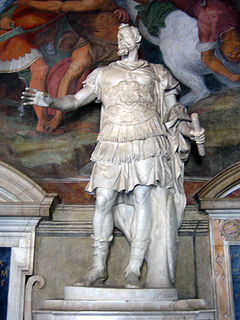
The Statue of Carlo Barberini was a large statue of the brother of Pope Urban VIII, Carlo Barberini, erected in the Palazzo dei Conservatori, Rome, following his death in 1630. The statue made use of an existing antique statue of Julius Caesar. The Roman authorities then commissioned the two most renowned sculptures of the day, Gianlorenzo Bernini and Alessandro Algardi, to add to the torso; Bernini worked on the head and Algardi on the limbs.

The Raimondi Chapel is a chapel within the church of San Pietro in Montorio, Rome, Italy. The chapel houses the tombs of two members of the Raimondi family, Francesco and Raimondo. Both the architectural and sculptural elements of the chapel were designed by the artist Gianlorenzo Bernini - it was one of Bernini's first works where the relationship between the sculpture and the architecture was considered as a whole. Elements of the sculptures were executed by other artists in Bernini's circle; Andrea Bolgi did the busts of the two Raimondi brothers and the accompanying putti. Niccolò Sale undertook the reliefs on the tombs, while Francesco Baratta did the larger relief in the central altar. Work on the chapel took place between 1638 and 1648.
















